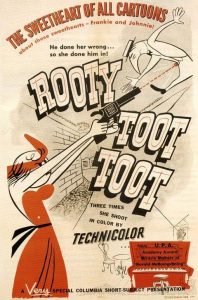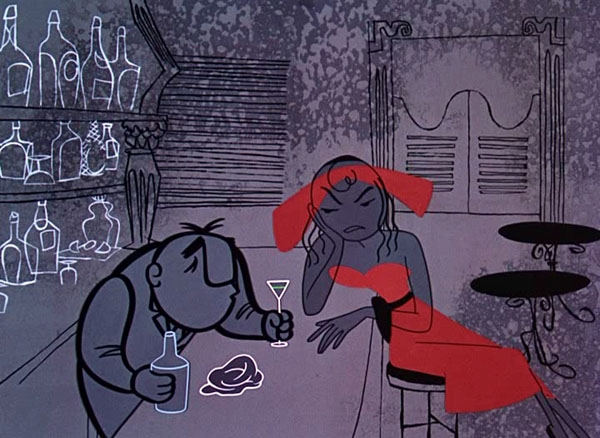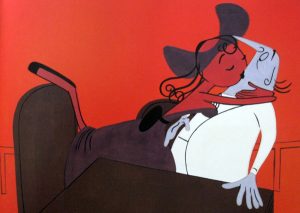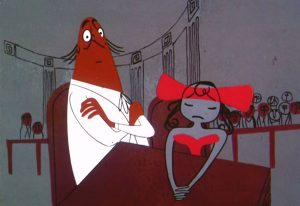 The debut of the short subject Rooty Toot Toot seventy years ago this month is as much a groundbreaking moment for animation as the first full-length feature, animated shows on prime-time TV, and the advent of computer-generated imagery.
The debut of the short subject Rooty Toot Toot seventy years ago this month is as much a groundbreaking moment for animation as the first full-length feature, animated shows on prime-time TV, and the advent of computer-generated imagery.
It tells a darkly comedic tale that would seem daring even for live-action films of the time, and it tells this tale in an ingenious way that creatively stretched the possibilities of the medium.
The film was produced by United Productions of America, UPA Studio. The studio was founded in 1941, in the wake of the animators’ strike at the Disney studio. Several artists who left the studio desired to create animation that was less realistic and more stylized.
This became the distinguishing foundation for UPA. The artists established their own, more modern graphic style, abandoning rich character design for bold caricatures and substituting sparse, geometric shapes for lush backgrounds.
The UPA style would influence animation at other studios, establishing the look for the industry during the mid-century.
In addition to visuals, the artists at UPA also expanded boundaries with their stories. One of these was most definitely Rooty Toot Toot, a story about a jealous lover and murder.

The short uses a popular song, “Frankie and Johnny,” as its basis with Frankie, who finds herself on trial for shooting her piano-playing boyfriend, Johnny. Slick attorney Honest John (voiced by legendary voice actor Thurl Ravenscroft) represents her, and a seductive singer named Nellie Bly is brought in to testify (voice actress Anette Warren voices both Nelly and Frankie).
With its demonstrative flashbacks, the trial moves at the whirling pace of its song, coming to the jury’s decision and then a twist ending.
 Through all of this, Rooty Toot Toot is groundbreaking in many ways. The distinct look of the short is as stylistic as anything UPA produced. Each character is a defined by particular shapes: Frankie, all thin lines and just a hint of red color in her hat and dress; Honest John, in his white suit, is a pear shape, and the judge is like a globe with arms.
Through all of this, Rooty Toot Toot is groundbreaking in many ways. The distinct look of the short is as stylistic as anything UPA produced. Each character is a defined by particular shapes: Frankie, all thin lines and just a hint of red color in her hat and dress; Honest John, in his white suit, is a pear shape, and the judge is like a globe with arms.
The backdrop of the courtroom is like a sparse stage play with few details and a jury and courtroom full of spectators who barely move.
Like all UPA’s films, it is in stark contrast to the lavish animation that had been such a standard of every major studio in the decades prior. However, even with this, Rooty Toot Toot uses its style to emphasize the action and humor throughout the short. When Johnny is shot, the bullets fly through the door and his needle-like frame with cartoon grace, and as Nelly Bly wrings her hands, her arms twist like braids.
Rooty Toot Toot tells its story in song, from the player piano that rolls out the opening credits to the concluding “slam” of “The End,” the music by Phil Moore, the first black musician to compose for the Hollywood studios, is infectious.
 At the helm for the short was legendary director John Hubley, one of the artists who left Disney during the 1941 strike. The animators who worked on the film were various fellow legends: Art Babbit, Pat Matthews, Tom McDonald, and Grim Natwick.
At the helm for the short was legendary director John Hubley, one of the artists who left Disney during the 1941 strike. The animators who worked on the film were various fellow legends: Art Babbit, Pat Matthews, Tom McDonald, and Grim Natwick.
Rooty Toot Toot was released on November 15th, 1951, and was embraced by critics, receiving an Academy Award Nomination for Best Animated Short Film.
In the seven decades since its release, appreciation for Rooty Toot Toot continues to grow as successive generations discover it. In 1994, it was voted number 41 in Jerry Beck’s book The 50 Greatest Cartoons.
Artistically and thematically, Rooty Toot Toot is something truly special. As author Adam Abraham wrote in his book, When Magoo Flew: The Rise and Fall of Animation Studio UPA: “Clearly Rooty Toot Toot cannot be mistaken for a Donald Duck or a Woody Woodpecker cartoon. Sex, jealousy, murder, infidelity, and a general air of prediction are new to the animated lexicon.”


 Michael Lyons is a freelance writer, specializing in film, television, and pop culture. He is the author of the book, Drawn to Greatness: Disney’s Animation Renaissance, which chronicles the amazing growth at the Disney animation studio in the 1990s. In addition to Animation Scoop and Cartoon Research, he has contributed to Remind Magazine, Cinefantastique, Animation World Network and Disney Magazine. He also writes a blog, Screen Saver: A Retro Review of TV Shows and Movies of Yesteryear and his interviews with a number of animation legends have been featured in several volumes of the books, Walt’s People. You can visit Michael’s web site Words From Lyons at:
Michael Lyons is a freelance writer, specializing in film, television, and pop culture. He is the author of the book, Drawn to Greatness: Disney’s Animation Renaissance, which chronicles the amazing growth at the Disney animation studio in the 1990s. In addition to Animation Scoop and Cartoon Research, he has contributed to Remind Magazine, Cinefantastique, Animation World Network and Disney Magazine. He also writes a blog, Screen Saver: A Retro Review of TV Shows and Movies of Yesteryear and his interviews with a number of animation legends have been featured in several volumes of the books, Walt’s People. You can visit Michael’s web site Words From Lyons at: 






















How I wish more UPA shorts were like Rooty Toot Toot. Typically, UPA shorts were very conservative and tedious. This film was a grand exception.
When I first saw Rooty Toot Toot I hated it. After repeated viewings, I realize what a work of genius it is. It was never part of a kiddie TV package for obvious reasons, so I never saw it until I was an adult.
When Nellie Bly’s arms twist into a braid, I get the chills.
Do any versions with a closing “UPA” title exist? Even on the Jolly Frolics DVD, the cartoon ends with the awful “A Columbia Favorite” title.
Check out the version in my past post on this site in the Animation Trails column, “Courtroom Drama: Deliberate Deliberation (Part 5)”, which includes a meticulous recreation of the missing end title. I couldn’t stand the “Columbia Favorite ” cut-in either! As I write in that column, I concur that this is the ultimate legal cartoon of all time, with the most strategic defense ever presented.
Rooty Toot Toot is an undoubted milestone. In my opinion, it’s the “Citizen Kane” of the cartoons. Just as Welles’ movie was a landmark that opened the door to modern cinema, “Rooty Toot Toot” did the same for the animated cartoon. Of course there was “Gerald McBoing” before him, but Hubley’s cartoon goes even further.
I know how you feel about having original closing titles and logos plastered over, usually by television re-packaging, Al & Charles.
I never saw “Rooty Toot Toot” on television re-runs, but I did see it for the first time in 1985 at a High School film run for a science project; “Rooty Toot Toot” was shown to the class by my 11th grade teacher as a special “bonus” before the main feature, a film about the anatomy (it was science class, after all).
The film print of “Rooty Toot Toot” I saw in 1985 was owned by the school’s film library (Pontiac Northern High School of Pontiac, Michigan) and may have been either a former TV station print or a Canadian TV print. The ending had the “A Columbia Favorite” title plastered over the original UPA logo, followed at the tail print of the reel the 1965 Screen Gems “S From Hell/Film Reel” logo (the Eric Siday theme, by the way, was the alternate “Hawk” synthisizer variant, also seen on rare prints of NFL Football film reels from 1965-70; my guess is it was a 1966 print, as Canadian TV stations used the “dancing sticks” logo for an additional year, from September 1965-September 1966).
Hawk was a Screen Gems TV show in 1966 starring Burt Reynolds aired on ABC; the logo had a “high-pitched” synthisizer sound composed by Eric Siday & Van Alexander. The “Batfink” Screen Gems logo had a trumpet fanfare composed (allegedly) by either Van Alexander, Raymond Scott, or Winston Sharples; the fanfare was similar to an alternate version of the “dancing sticks” composition (composed by Frank DeVol.) But I digress…
As abrupt and annoying as the plaster was, it still did not take the entertainment value out of the performance of the cartoon; it was an old 16-mm film print, after all. TV stations at the time simply didn’t run “Rooty Toot Toot” as a re-run staple for kids, probably because the subject matter (drinking alcohol, cheating on loved ones, planned extortion, and finally, murder at the end.) was too sensitive for TV stations to handle for complaining parents at the time. Of course, 55 years later, a lot has changed in the animation world with mature themes aimed at kids.
Original Title geeks strike again! I’ll never understand how 24 frames of a perfectly okay end title card can inspire so much disdain, to the point that someone makes most of their comment about it. I do hope you liked the cartoon. I’ll go away now.
Re: Peter Mork: Yes, Pete, we are original logo geeks, and we wear it with pride.
It’s something to be nostalgic for old logos & titles we Boomers & Generation X adults used to see when we were kids watching a lot of TV & movies; Of course, I’m a Generation X’er myself (born 1968), so Screen Gems was very important to me when it came to identifying things I saw as a baby or toddler on TV. The fact that Sony plasters a lot of these wonderful old logos is a distraction; still, the UPA style of cartoons remains as timeless as ever in 2021 as much as it was in 1949-59, done by freelanced artists like John Hubley before they were cheapened by Henry G. Saperstien (the exceptions being “Magoo’s Christmas Carol” & “The Famous Adventures Of Mr. Magoo”.)
The 1956-1975 NBC Peacock was another logo giant that was equally just as important. Of course, various different ideas (such as Canada using the Dancing Sticks for an additional year, unlike anyone else in the world) are equally just as fascinating, and historical. those who saw the original UPA logo on movie screens in 1951 feel that an important moment in animation history has been lost forever by careless media giant purchasing. As such, those who saw the original UPA logo at the end of “Rooty Toot Toot” would be passed the age of 65-70 by this point. As for the cartoon alone, it was wonderful.
Sure, but you could make a case that “A Columbia Favorite” is part of the film’s history too.
In any case, I watched lots of Popeye cartoons on TV growing up with “AAP” spliced onto the beginnings; it didn’t ruin the experience for me because I paid no attention to it. If, years later, I cared to investgate and discovered that AAP had nothing to do with the making of Popeye cartoons, that’s an easy fact to find. There’s no chance of “animation history” being lost.
I know your comment isn’t the geekiest in all of geekdom, but I find it odd the amount of attention expended by some on the peripherals, things like logos (UPA’s just a logo too) as guarantees of authenticty, especially coming from young people who likely never saw a cartoon projected in 35mm, between a newsreel and a Doris Day movie, with a guy in front of you smoking a cigarette or unwrapping a candy bar.
Peter, I agree with you. I get tired of reading posts about titles that ignore the cartoons. I’m a Disney fan, and love their short cartoons, even though the cartoons rarely have the original titles intact. I saw them with the old Buena Vista titles when I was a child and never mind seeing those re-release titles again on DVD.
Chuck, did I say in my last two posts above that I ignored the cartoon? I would say absolutely not, I just think that original titles & logos are very important to the part of the cartoons, that’s all.
Do I miss episodes of “The Flintstones” with the Screen Gems logos (both dancing sticks & “S From Hell” variations)? You bet I do, though later prints with Ted Turner’s logo, or Cartoon Network’s “Action of comedy characters & sound effects” logo, and the recent Warner Brothers W-B shield ending “Flintstones episodes are equally as historical; it’s just logo buffs who remember the original SG logos aired on ABC TV 1963-66 (and later NBC & CBS Saturday Morning re-runs) will not forget about the logos that follow Fred’s yell of “Willlmmaaa!”
Keep in mind that while some logo fanatics like myself enjoyed a lot of the 1950’s-70’s logos, there were (supposedly) a number of children in the 60’s & 70’s who were terrified of some of these logos (The “S From Hell” definitely comes to mind; why else would Rod Arscher make a sarcastic, short cum-documentary of the logo in 2011.
Quentin Tarrentino was also quite fond of the “S” logo as well, as it appears as a shock-scene/suspicious appearance on a tv screen on his film “Once Upon A Time In Hollywood”.)
As for the cartoon of “Rooty Toot Toot”, if you want my favorite descriptions of the animation, I’ll just say my favorites were the lovely Frankie scenes; she moves so gracefully across the screen as the spurned lover that went wrong with moral values. Phil Moore’s musical score was very nice, too.
Please don’t underestimate us logo fanatics, though. We’re here on the web, too, always trying to search for (hopefully) re-constituted prints of old films that seemingly have disappeared over the years as they have either been accidentally destroyed (like MGM & Universal’s vault fires) or have been accidentally thrown out over the years by careless staffers or TV censors.
Our closest sources today in finding stuff like this would be on computer blogs like YouTube or Vimeo. Or if we’re lucky, finding a film expert at a major or minor studio that could resurrect long lost film prints. Thank you for your time patience. (P.S. “Disney’s “Buena Vista” logos from the 1950’s-1980’s were all very nice.)
Sorry if I sounded harsh, but we live in an age where it is possible to see the cartoons that when I was in my twenties, I could only read about. All I knew about “Rooty Toot Toot” back then was one black and white still in “Of Mice and Magic”. It is so much nicer to have the DVD and the YouTube to access and to see the actual cartoon.
Despite all the great animation, my favorite shot (no pun intended) is the hold of Frankie with gun and swinging follow-through of the exhibit A tag. More effective than if we were to see her pick up the gun and shoot it. In animation, when not to move is just as important as when to move. More conventional thinking would show Frankie shooting and then cut to the result of her shot. The direction here flips that.
Thanks for this warm reminiscence of a remarkable film. Just to be clear, in the quote you cited, it should be “a general air of perdition.” And, yes, “Rooty Toot Toot” is a gem.
Always loved Frankie’s ballet-like walk when she’s introduced in the cartoon. Very graceful and comical at the same time in my opinion. Definitely one of my favorite all time cartoons!
THIS IS THE BEST CARTOON EVER. Like, the best UPA cartoon, imo. Absolutely love how the backgrounds color changes when the mood shifts. The music, the backgrounds, the character designs, JUST EVERYTHING ABOUT THIS CARTOON IS GREAT! I get HUGE chills when the music stops, Frankie shoots Honest John, and I love how the background shifts from a red to blue-ish grey-ish tone as the mood changes. This cartoon is a masterpiece, artistically, conceptually, and musically. 1000/10.